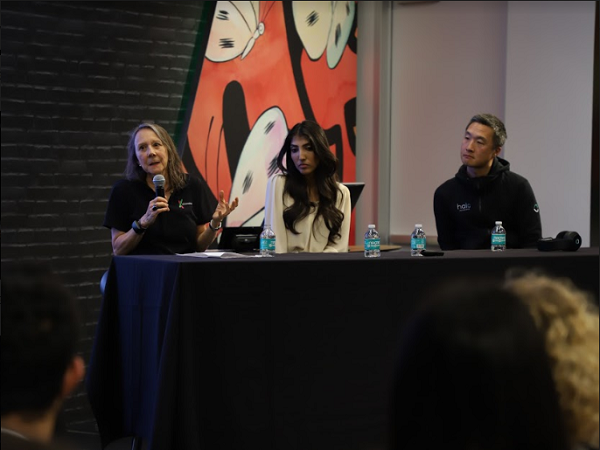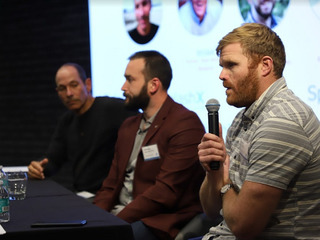

On Thursday, Vator and HP held their holiday salon gathering, called SplashX Invent Health – Vitality: Lifestyle as a drug, where a group of innovators, adopters and financiers got together to take a deep dive into new innovations and frameworks that could get people to be more proactive about lifestyle modifications.
There was a lot of talk about adherence and motivation in getting people to stay healthy, but that brings up another question: how much do external factors weigh in on our health?
That was the topic broached by the second panel, made up of entrepreneurs in the healthtech space. Panelists included Esther Dyson, Executive Founder at Wellville; Hemalee Patel, Lifestyle Medicine Physician at Crossover Health/Facebook; Munjal Shah, CEO & Co-founder of Health IQ; Seth Serxner, Chief Health Officer and Senior Vice President of Population Health at UnitedHealthcare Optum; Pankaj Vij, Kaiser Lifestyle Medicine, President at American College of Lifestyle Medicine; and Daniel Chao, CEO of Halo Neuroscience. The panel was co-moderated by Archana Dubey, Global Medical Director at HP, and Frances A. Ayalasomayajula, Senior Manager, Worldwide Healthcare at HP.
Dubey started the conversation addressing Dyson: “They say that the zip code that you live in has far more impact on your health outcome than the genes that you were born with.”
Dyson has been overseeing her Wellville project for more than four years. It’s a national non-profit helping to reinvent several cities to think long term about their health. You can read Bambi Francisco Roizen’s write-up of Dyson’s venture here: Esther Dyson’s Wellville project four years in.
Dyson agreed with Dubey’s premise about zip code being more important than genetics.
Lack of healthy food; higher crime rates
“Basically it’s true. In Muskegon, for example, there is, it’s not a fashionable term anymore, but there’s what amounts to a ghetto, Muskegon Heights, and they measure the crime rate per 10,000 versus per 100,000 and in other parts of Muskegon it’s much nicer, much whiter, and the disparities are huge in outcomes. We’re not in the business of doing experiments on people so we haven’t taken anyone out of Muskegon Heights and transplanted them but it’s not unique to our places. The situation you grew up with, your access to food. No, not everybody’s a victim but, at the same time, if you can’t get healthy food, I’m sorry, that’s not your fault. And that doesn’t mean all we need to do is bus in food; it’s very, very complicated,” she said.
“People’s futures are determined. With Kaiser Permanente, the other interesting work that was done there was by Vincent Felitti who studied adverse childhood experiences. You had people who seemed to be okay and then at 30, suddenly something explodes; others much earlier. If you’re missing parents, if one or both of your parents are addicted to something, if somebody’s in jail, your chances of all of these things going wrong for yourself is this depressing linear curve.”
Crossover/Facebook’s Patel spoke next, mentioning how access to technology also plays a role in health.
Limited medical record data
“When it comes to high tech, in terms of digital electronic health records being accessible to patients, population health plays a huge role. Which patients are actually on their phones versus which patients have access to other ways of getting their health records and how important that is in driving outcomes. We see that in the hospital and outside the hospital as well, that patients coming in from a county setting may not have the access and it’s actually really important that they may be on their phones because translation is actually easier done on their phones. So, how do you get them access that will drive better outcomes for them while they’re in the hospital, and you have such limited time because you may be the last provider that they see before they disappear,” she said.
“Jail systems are a great example of that as well; how do you have inmates have access when they come into the hospital? How do you keep track of their records? How do they keep track of their records, so that when they are finally discharged from the hospital, and subsequently discharged from prison, they actually have an idea in terms of their outcomes. So I think it plays a massive role.”
Dubey then asked a followup question: “What are the interventions that have been done that have been successful? We know the zip code matters but what are success stories attached to that?”
Community outreach is key
“Social disparities in health, and health equities, are a very hot topic,” said Optum’s Serxner. “Community context, blue zones, all that stuff. We have a lot of information about that. For example, in Medicaid populations around maternity health, we see great success with some baby text apps. The other piece to that is social disparities in health and social isolation go together quite a bit. So, we have an index on social isolation and we know they’re at risk for many, many things. In fact, if they smoke and they’re lonely, I’d rather them get a friend than quit smoking.”
Serxner said continuous outreach is key. “In this case, we go to their home; we have house calls. We do over a million house calls to people who are in social isolation, do assessments, if they need to adjust their environment we’ll help them adjust the environment. We’ll help to overcome their barriers. So not all technology to help in this case.”
In this vein, Dyson mentioned SAMHSA.gov, the website for the Substance Abuse and Mental Health Services Administration, and a nurse family partnership program they offer, which focuses on high-risk, first-time pregnant women, giving them a visiting nurse that stays with them for two years.
“Peter Orszag from the Office Management and Budget swears by this thing, it gives you a seven times financial return in something like 20 years. If you’re rich and you don’t want to pay taxes, you should pay taxes for this because you’ll pay less taxes later. These kids who come out of what would be a very risky circumstance, they’re more likely to finish school, more likely to get pregnant or get someone else pregnant, less likely to get addicted, more likely to get a job. And it all goes back to that initial resilience and it really works and it makes you able to listen to the advice and pay more attention to it and so forth,” she said.
When Shah spoke, he brought it back to the original question about the importance of zip codes.
“We recently did analysis because part of how we started the company was we actually wrote a health IQ test. We got millions of people to take it, so we actually have this data set that shows basically health literacy across the country zip code by zip code by zip code. The other day I was looking for something and so we ran this report, and we’re going to put out this infographic, and we said, ‘Hey, what’s the disparity between genders?’ And we expected the normal thing that you would see: typically lower scores in women and higher scores in men,” he said. (This did not make the women in the audience very happy, and they let Shah know it.)
“What we found was the exact opposite. So, in every single state but one, for reasons I cannot explain, basically there’s a gender gap in literacy, where the men are less literate. Except, interestingly, the poorer the state, the bigger that gap or the smaller that gap? The bigger the gap. And, so, we’re starting to be able to get, and a lot of this literacy is the foundation. Knowing isn’t going, but you can’t do what you don’t know.”
Sometimes low incomes = high health literacy
Some of the other things that Health IQ has found, he noted, is that, while, normally, high income equals high health literacy and low income equals low health literacy, there are pockets all over the country where there is low income and high health literacy.
“We’re starting to try to figure out, why is that? What happened in these pockets? Is there something we can replicate to other pockets? We don’t have to just accept the normal orthodoxy of this; let’s let the data tell us, and let’s let the data help us find these contrarian things we can see. And maybe there’s an insight in that as well. Not always. Some of the ones we found were just university towns, so that didn’t teach us anything, it’s just a bunch of 22 year olds making no income but are very well educated. So that’s some of it, but we’re looking at the data in a very different way around literacy.”
















